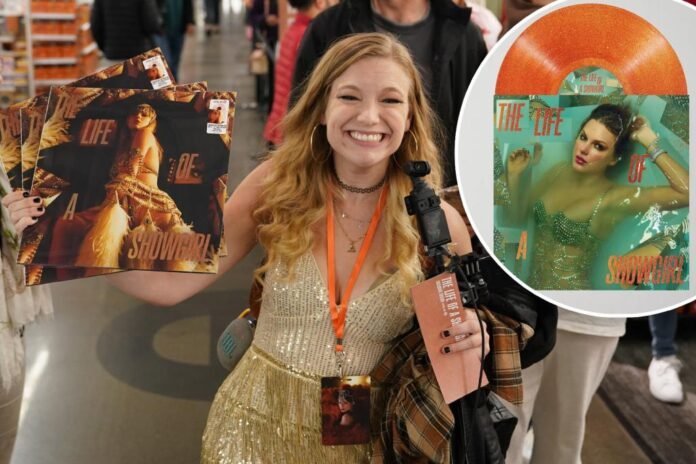Taylor Swift fans can breathe easy when grabbing her latest album—no extra tariffs to worry about.
The Trump administration rolled out new tariffs on Friday, August 29, ending the “de minimis” exemption that let billions of small imports slip into the US without fees. But physical music products dodged the bullet, thanks to a quirky Cold War-era rule called the Berman Amendment. This part of the International Emergency Economic Powers Act blocks presidents from controlling “informational materials” like music, books, and art.
That means vinyl records, CDs, and cassettes stay tariff-free. Swift’s new release, “The Life of a Showgirl,” hit stores on Friday, and buyers won’t see surprise charges at checkout. “If vinyl had gotten hit with tariffs, prices could have jumped to $40 or $50 per record,” says Berklee professor Ralph Jaccodine. He told CNBC this exemption is a big win for anyone snapping up physical music.
Vinyl records are staging a massive comeback in the music industry. Young fans and collectors are driving the trend, with vinyl now accounting for nearly three-quarters of US physical music revenue. That’s a 20% spike since 2020, according to the Recording Industry Association of America. “This carve-out for physical formats is encouraging and a relief,” says Ryan Mitrovich, general manager of the Vinyl Alliance. But he cautions that the global trade scene remains unpredictable, so don’t count on it forever.
Major labels like Universal Music Group (UMG), which puts out Swift’s albums, felt the vinyl boom last quarter. UMG reported a 9.6% revenue increase in Q2 2024, fueled by a 14.4% jump in physical sales. Swift played a huge role—her previous album sold 3.49 million copies across formats. Even with a recent dip in physical revenue and a 24% stock drop for UMG, experts predict Swift’s new drop could change everything. Some forecasts call for over 1 million vinyl sales in the first week alone.
“Taylor Swift has a unique power to shake up the market with her release strategies,” Jaccodine adds. “This album could spark a real boom in the music business.”
Not everyone in the industry cheers the exemptions. Some US vinyl manufacturers back the tariffs—not to shield consumers, but to pump up American production and jobs. Alex Cushing, co-founder of Hand Drawn Records in Dallas and a board member of the Vinyl Record Manufacturers Association, explains his team cranks out 2 million records a year with just 60 workers. But they can’t scale up for Swift-sized demand.
The catch? Raw materials like PVC and ink already face tariffs, pushing much of the manufacturing overseas. Czech giant GZ Media, which handles one in four albums worldwide, produces many US records abroad. GZ CEO Michal Štěrba warns that broader tariffs would hike prices for everyone. Cushing agrees on the price impact but sees a silver lining: Tariffs might steer smaller artists back to US factories, where production isn’t geared for mega-runs yet.
For artists, physical sales beat streaming hands down. Streaming pays just $0.003 to $0.005 per play, while vinyl, CDs, and cassettes offer 10-25% royalties. “Unless you’re one of the top few acts, streaming won’t keep you afloat,” Jaccodine says. “Merch like records, CDs, cassettes, hats, hoodies, and concert tickets—that’s the real money for big and small artists alike.”
Swift’s Eras Tour raked in over $2 billion from tickets, while streaming added $200-400 million. Physical releases keep forming a key part of that revenue mix. A UK survey by Key Production found nearly 60% of 18- to 24-year-olds tune into physical music—the top rate across age groups. On TikTok, “vinyl hauls” videos draw millions of views, and limited-edition colored LPs trigger #FOMO buying sprees.
Insiders call it a pushback against the digital world. “People spend so much time on screens, paying to access stuff they don’t own,” Cushing says. “Vinyl gives that tangible ownership—it’s the opposite of easy streaming, and that’s exactly why fans crave it.”
Swift knows how to play the variants game. Her last album came in 36 editions across formats, with vinyl exclusives featuring special artwork and bonus tracks. Each version can pull in millions, and her dedicated fans line up to buy them all.
“As long as a new vinyl stays under $75, it’s worth every penny,” says 24-year-old fan Tayra McDaniels. “Collecting them is like an addiction, but I love it.”
Stay informed on all the latest news, real-time breaking news updates, and follow all the important headlines in world News on Latest NewsX. Follow us on social media Facebook, Twitter(X), Gettr and subscribe our Youtube Channel.



